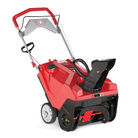Winter can be filled with intense weather conditions that place snow removal at the top of many to-do lists all season long. While snow blowers are often used to clear snow quickly and easily, unanticipated equipment issues can occur, setting you back on time, as ice and snow continue to build up outdoors.
A few of the most common snow blower equipment problems individuals run into are starting issues, clogged chutes and drive loss. Knowing how to fix a snow blower, along with the proper maintenance and tools, can often resolve these issues.
Consider these snow blower troubleshooting tips to help get your snow blower up and running to take on all that winter will bring. Whatever the maintenance task may be, you should always read your owner’s manual and wear protective eyewear and other necessary safety gear.
Snow Blower Won’t Start
Because your snow blower has been sitting unused throughout the warmer months, revving it up at the start of the snow season may require some coaxing.
- Begin by draining gas from your snow blower left in the tank from the previous winter, and replace it with clean, fresh fuel.
- Next, check the dipstick to make sure you have adequate oil – running your snow blower with little or no oil can damage your engine. Depending on your dipstick, it may be time for a snow blower oil change. It’s also important to set the choke and push the primer bulb a few times before your first pull (if your snow blower is equipped with those features). Some models, like the single-stage Squall™ 179E Snow Blower, have push-button electric start, which eliminates pull-starting.
- Lastly, check your snow blower spark plug to see if it’s unplugged, corroded or covered in buildup. If you spot one of these issues, try cleaning or replacing your spark plug by following the instructions in your owner’s manual.
How to Keep Snow Blower from Clogging
Many snow blowers, like the two-stage Storm™ 2600 Snow Blower, have adjustable chutes that enable you to control the direction and pitch of snow as you clear. Depending on your snow blower model, objects and particularly heavy, wet snow can clog your snow blower’s chute, prompting you to make a quick fix on the fly.
- Never use your hands to clean a clogged snow blower chute assembly. Release both the auger control and drive control, shut off the engine and remain behind the handles until all other moving parts of your snow blower have stopped. Stop the engine by removing the ignition key.
- Next, use the shovel-shaped end of the clean-out tool to break down and remove any snow and ice that has formed in and near the clogged snow blower chute. (On most Troy-Bilt® snow blowers, the chute clean-out tool is fastened to the rear of the auger housing with a mounting clip.) Once you’ve cleared the chute, simply refasten the clean-out tool to the mounting clip.
- When the clearing is complete and all tools are safely put away, reinsert the ignition key and start your snow blower. While standing in the operator’s position (behind the snow blower), engage the auger control for a few seconds to clear any remaining snow and ice from the chute assembly.
Snow Blower Augur Not Turning or Drive Loss on a Two-Stage Snow Blower
If you experience your snow blower auger not turning or loss of drive control, it may be necessary to perform one or a combination of the tasks listed here:
- Inspect and perform the cable adjustments listed in the “Final Adjustments” section of the snow blower “Assembly” section of your owner’s manual. Snow blower cables do stretch over time; performing these adjustments will tighten any slack that may have occurred due to stretching.
- It may be necessary to inspect, and possibly replace, one or both belts. These belts operate the drive systems for the wheels and the auger.
- If the belts seem fine and the engine runs, but the augers have lost half or full operation, broken shear bolts are likely the failure. Inspect the shear bolts and replace as needed. Snow blower shear bolts are located along the main auger shaft in the center of each auger spiral. Refer to the illustrated parts list for specific location and replacement part numbers of these shear bolts.
For loss of wheel drive, begin with inspection and replacement of the rubber friction wheel (as needed). This rubber friction wheel is considered a normal service wear item, and snow blower wheel replacements should be considered when the thickness of the exposed rubber wears to approximately 1/8 inch. This is a drive component essentially responsible for transferring power from the belts to the drive wheels. Operating the unit with worn-out friction rubber may result in damage to the drive system. Check this friction rubber regularly for wear. Consult the owner’s manual for more information on friction wheel maintenance.

